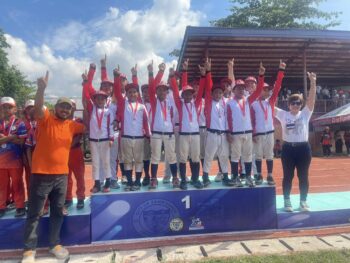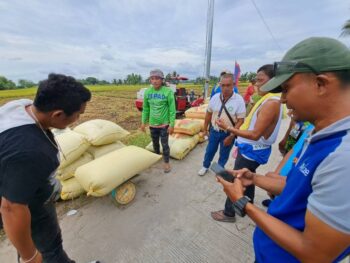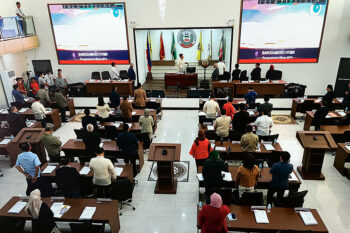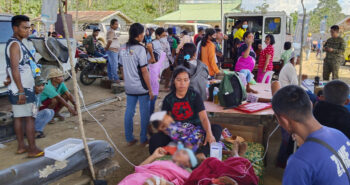«Saan ko hahanapin ang
heograpiya ng gunita
na kasabay na tinibag
ng pagbuldoser sa lupa?”
- “Buldoser” by Nikki Mae Recto, a writer-accountant from Valenzuela
BERN, SWITZERLAND (MindaNews / 16 Aug) — Today was one of the few times that I could watch up close a house being demolished.
From my vantage point twelve floors up in our apartment, I had marvelled at the skills and dexterity of the Swiss worker operating a backhoe. The guy was doing maneuvers simultaneously, like moving back and forth while delicately picking out metal pieces from the rubble. He was very good at using his joystick and control levers, a complete professional.
And then he did something which made my blood run cold. A large conical piece of metal was giving him a little difficulty. He had tried scooping up the unwieldy piece into the backhoe to no success. Then abruptly the operator decided to squash the metal on the back end of the hoe; in a second, the piece was flattened. I wondered how many pounds of pressure were exerted on the metal.
My blood ran cold because I remembered that a backhoe- along with bulldozers – were used in the massacre of Filipino journalists in Maguindanao nearly 10 years ago. I imagined that backhoe being used not on metal but on flesh and blood, some of whom were still alive when their bodies were bulldozed and covered along with their vehicles in a hastily-dug mass grave intended to cover the crime.
The “Ampatuan Massacre” is the worst recorded attack on the Philippine press, with up to 32 media people killed in a single day, along with 26 other civilians. The media people had accompanied the civilians to report on the filing of an election candidacy in Maguindanao province, the bastion of the Ampatuans. A rival was challenging the Ampatuan patriarch who was incumbent governor at the time. The convoy was stopped on the highway by around 100 armed men and the people were abducted and brought to a hill in Ampatuan where they were all shot and later buried.
Evidence was presented that some of the female victims were raped before being killed, with all of the women shot in their genitals and beheaded. Two of the women were pregnant at the time of their murders.
Mindanao journalists insist on calling this coldblooded murder the “Ampatuan Massacre” not only to record the place in infamy, but also to exact accountability for members of the Ampatuan clan that had controlled Maguindanao politics since 2001 through guns, a well-stocked private army and lots of money.
The nearly 200 suspects included the family patriarch, Andal Ampatuan Sr. and his son Andal Ampatuan Jr. and several other members of the Ampatuan clan, some of whom were elected mayor or to other high posts in the province at the time. All were charged with murder.
The Ampatuans were allies or party members of political leaders of succeeding administrations, who bestowed money and political favors on the clan for their capacity to deliver votes from Maguindanao province during elections.
The massacre occurred on November 23, 2009, during the administration of Gloria Macapagal Arroyo, a former president who was jailed for plunder but whose case was dismissed by the Supreme Court on July 19, 2016, a few weeks after Rodrigo Duterte was sworn in as president.
A known senator and lawyer had said then with marked exaggeration that with nearly 200 defendants and 300 witnesses, the trial could take 200 years. The sad truth is that nearly ten years later, justice seems to have escaped the victims and their families.
The suspected mastermind, the family patriarch Andal Ampatuan Sr., had died in 2015 from disease, but some of the Ampatuan members have obtained bail. Over the years many of the witnesses have died, or were killed by armed men under suspicious conditions or have retracted from their testimonies or moved away to anonymity. So have many prosecution lawyers who had stepped away from the case citing conflict of interest. Not a few government prosecutors were charged by their private counterparts of having been bribed, some reportedly for as much as 300 million pesos – a staggering sum of money.
In late 2018, Philippine Justice Secretary Menardo Guevarra said that he was hopeful of a decision handed down on the case within the first half of 2019. That has not happened yet.
Another footnote on this case that is relevant today is that because of the outcry over the massacre, on December 4, 2009, then President Arroyo had placed Maguindanao province under a state of martial law, thereby suspending the privilege of the writ of habeas corpus. She had lifted martial law nine days later.
When I finished writing this piece, I looked out again to the backhoe, now lying inert and lifeless in the rubble of the destroyed house.
I had not expected that my moment of childlike fascination at the operation of the backhoe had turned nightmarish at the memory of the Ampatuan massacre. But those grisly details need to be relived, just as Filipino journalists and the victim’s families are asking us on the tenth anniversary of the massacre, because justice remains unserved.
(Mindanawon Abroad is MindaNews’ effort to link up with Mindanawons overseas who would like to share their thoughts about their home country and their experiences in their adopted countries. Brady Eviota wrote and edited for the now defunct Media Mindanao News Service in Davao and also for SunStar Cagayan de Oro. He is from Surigao City and now lives in Bern, the Swiss capital located near the Bernese Alps)







